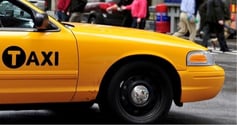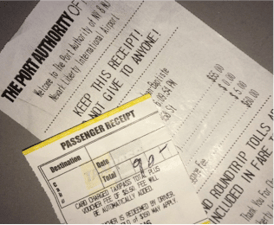Oh, the irony - I love it when material for a speech just lands in my lap.

I was at NextBank USA in New York this week, delivering a Thursday morning keynote on removing friction from customer experience. To get there from San Francisco, I flew Virgin America into Newark. As usual, the airline experience was pretty good; as a customer experience exec, I’m pretty aware of companies who get it right – as well as those that don’t. And in fairness, my cab ride from Newark to mid-town was fine too. But the Port Authority’s approach to credit card payments for the cab was priceless.
Given NextBank’s focus and attendees, my topic was obviously on financial services, the friction that occurs along different customer journeys and examples of smart solutions to some of the pain points customers experience along the way.
The irony is that credit card processing by cabbies was one of my examples of friction in customer experience – and how Uber solved it. And while I give The Port Authority of NY&NJ full points for identifying this as a pain point, their solution was a Rube Goldberg-esque example of how NOT to fix a painful customer experience. That solution was both a laugh-getter in my speech, the genesis of this article, and the source of five valuable lessons for anyone trying to remove friction or pain from the customer experience.
Pain point, counter point. Two solutions to in-cab credit card processing pain.
If you use a credit card in a taxi cab, you usually need to hand it to the driver when you get to the destination where they run the card on portable card readers. Receipts are printed and signed, tips calculated. It does take a few minutes, not horrible, but it’s a manual process and a noticeable period of time.
The problem: Cabbies lose “billable” time waiting for cards to process, and passengers are equally frustrated. They just want to get out and on their way.
The big idea: Pretty simple: eliminate in-car credit card transactions. But as it turns out, the challenge is in how you implement the solution.
The Uber solution: Your card is in the cloud. You get in the car and go; when you arrive at your destination, you get out. That’s it. Your card is charged, and the driver is paid. Neither of you see or touch the card. No friction, no pain.
The Port Authority of NY&NJ Solution: On exiting the terminal, you head to the cab stand. No signs or anything, but if you’re persistent someone will point you to a black machine that says “vouchers” on the front. Turns out you need to pre-authorize your card for $150, and the machine prints you out a “voucher” that’s kind of like a check just for cabbies.

You show the voucher to whoever is manning the cab stand, and they provide you a receipt for the voucher, which you have to show to the cabbie as proof you’ve paid. When you arrive at your destination, the cabbie tells you the amount due is actually far greater than the amount on the receipt, but you pay it anyway. Then you have to fill the voucher out, endorse it, and hand it over to the cabbie.
At the end of his or her long shift, the cabbie has to (I’m assuming) take their stack of vouchers and enter them into a computer program of some sort before they get paid.
Lessons learned: Five take-aways for customer experience executives.
So, for both the Uber and Port Authority solutions the end goal is the same – in-car credit card transactions are eliminated.
For Uber, one pain point becomes no pain point. But the Port Authority succeeded in taking one pain point and spreading it out, creating at least four new pain points for a single transaction, distributed across all parties. Ouch.
So how can you think more like Uber when it comes time to start designing solutions to your customer experience problems? I could make the list longer, but these five lessons are a great way to start…
- Know who you’re solving for: If you have a clear understanding of the people you’re solving for, it makes it easier to design solutions with them in mind. In this case, solving for both drivers and passengers would give you the ability to look back and ensure that what you’ve designed actually solves the problems they have.
- Identify the root causes of a problem: In this instance, a big part of the problem is that it takes too much time to process the card; adding more time, even if in a different place (or two), doesn’t resolve a root cause of the original problem.
- Simplify the customer experience: In general, the more steps in an experience, the more friction there is. Simplifying the experience usually means fewer steps for customers, along with everyone else involved in the journey. As you design solutions, just remember: simplify.
- Automate and simplify processes: Uber removed complexity by removing the manual process entirely, and automating the solution. The Port Authority added a series of additional processes, increasing overall complexity because many of them are also manual. Automating processes is a desired end-state.
- Test and validate solutions before you roll out: I have to assume that anyone who actually tested this process in the field would have killed it before it got to functional specs, much less an implemented solution. Ideas that seem great in a boardroom often die in the crucible of real life – and that’s as it should be.
While not a great deal for cabbies, travelers, the Port Authority or taxpayers (who I’m guessing paid for the design, implementation and ongoing maintenance of the solution) the Port Authority approach does provide some important lessons for customer experience executives. So please, don’t let these mistakes be in vain. Use the lessons they can teach us all to make better experiences for your customers.

